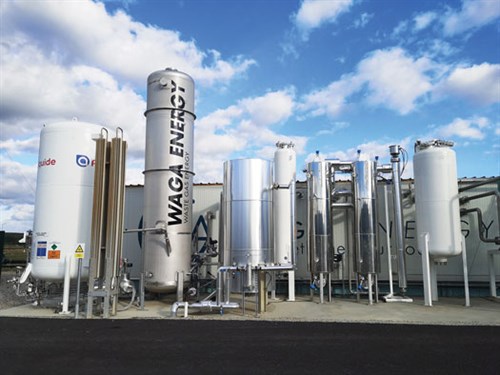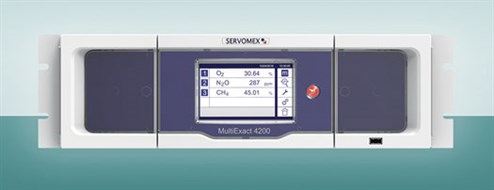New in Gas Processing Technology
Waga Energy to deploy RNG technology in Quebec
 |
Waga Energy has been enlisted by the Mauricie Residual Materials Management Board to deploy its landfill gas-to-renewable natural gas (RNG) technology at the Saint-Étienne-des-Grès landfill in Quebec, Canada. The green gas produced will be purchased by gas distributor Énergir for injection into its gas grid onsite. The landfill gas-to-RNG project, which will run for at least 20 yr, will be the first in Canada to use the WAGABOX technology, which was developed to recover landfill gas as biomethane.
The recovered biomethane will be upgraded into grid-compliant RNG by a WAGABOX gas treatment unit built onsite. The landfill gas at Saint-Étienne-des-Grès was previously captured and burned in a flare. Designed to process 3,400 m3/hr of biogas, the WAGABOX unit will produce 468,000 GJ/yr of renewable gas, corresponding to the consumption of 8,000 local households and preventing the release of 23,000 tpy of CO2 into the atmosphere. The project is scheduled to be completed by 2022.
Servomex upgrades flammable gas analyzer
 |
Servomex’s SERVOPRO MultiExact 4200 analyzer provides high-specification multi-gas analysis of flammable gas samples and trace contaminants in applications including HyCO, syngas, hydrogen production and gas transfer applications.
Utilizing paramagnetic, infrared and gas filter correlation sensing technologies, the MultiExact 4200 analyzer measures up to four gas streams simultaneously, with percentage measurements for O2, CO2 and CO. It can also be configured to measure percentage CH4 and ppm-level CO, CO2, CH4 and N2O.
The analyzer has a built-in LCD screen and provides alarm, fault and calibration logs. An automatic calibration option reduces ongoing operational requirements. Other benefits include minimal maintenance requirements and a low cost of ownership.
GTT upgrades NO96 technology
GTT has developed the NO96 Super+, an evolution of the NO96 Cargo Containment System (CCS), which has received an approval in principle from Bureau Veritas.
The NO96 Super+ technology integrates insulating reinforced polyurethane foam panels instead of plywood boxes to reduce the heat ingress inside the tank. Glass wool flat joints are also inserted between adjacent foam panels to optimize the behavior of the system and ensure it the best thermal performance.
These modifications allow GTT to further reduce the evaporation
of the cargo during operations, with NO96 Super+ offering a guaranteed boiloff rate of 0.085 vol%/d for a standard LNG carrier with a capacity of 174,000 m3. Further reductions down to 0.08 vol%/d are possible for larger capacities, such as 200,000 m3.
BW LNG signs digitalization deal
BW LNG has signed a deal with Kongsberg Digital and Alpha Ori Technologies for a digitalization partnership to realize digital capabilities that enhance efficiency and reduce the environmental footprint of LNG carriers (LNGCs) and floating storage and regasification units (FRSUs).
The agreement encompasses several projects, including utilizing a common data management platform and developing a maritime digital twin and digital processing models. The aim of the partnership is to enable the acceleration of technologies needed for future-ready LNG carriers and FSRUs by leveraging Kongsberg Digital’s data infrastructure technology, Vessel Insight, together with Alpha Ori’s SMARTShip digital applications and BW LNG’s operational expertise and assets for piloting a maritime digital twin and a real-time decision-support system.
A pilot project has been established to develop and test a maritime digital twin developed for the BW Magna FSRU, utilizing the Vessel Insight data infrastructure, Kognifai digital platform and maritime simulators from Kongsberg Digital, as well as value-adding expert applications from Alpha Ori. The pilot will illustrate an example of the benefits of digitalization for the industry.
Silverstream Technologies completes LNGC trials
Clean technology company Silverstream Technologies announced that its pioneering air lubrication system, the Silverstream System, has delivered significant fuel and emissions savings during testing on the Shell-chartered 170,000-m3 LNG carrier Methane Patricia Camila.
Following operational testing of the retrofitted technology, Silverstream and Shell’s engineers demonstrated 6.6% net savings generated by the Silverstream System. The technology was tested at various vessel speeds during Methane Patricia Camila’s normal operations, to calculate fuel and emissions savings.
The Silverstream System enables fuel and emissions efficiencies through its unique design. The technology produces a thin layer of microbubbles along the full flat bottom of the vessel, reducing frictional resistance between the water and the hull.
The system was successfully retrofitted on the 2010-built LNGC during its October 2020 planned dry docking at the Sembcorp Marine Admiralty Shipyard in Singapore. From design through to installation, the system was reviewed and approved by ABS in accordance with its guidance note for air lubrication technology.
Honeywell enables large U.S. CCS project
Wabash Valley Resources LLC has selected a range of Honeywell UOP technologies to capture and sequester up to 1.65 MMtpy of CO2 and to produce clean H2 energy from a repurposed gasification plant in West Terre Haute, Indiana. The project is expected to be one of the largest carbon sequestration initiatives in the U.S. to date.
UOP will provide technology licenses, basic engineering and specialty equipment including a modular MOLSIV molecular sieve dehydration unit, a modular Ortloff CO2 fractionation unit and a Polybed pressure swing adsorption (PSA) unit to sequester CO2 and process synthesis gas from the gasification unit. The Ortloff CO2 fractionation technology will produce a high-purity liquid CO2 stream while separating an H2-rich stream that will be purified by the PSA unit. The CO2 stream will be sent for permanent geological storage.
Chart, ABB to standardize controls for LNG, biogas, H2
Chart Industries has signed a development and commercial MOU with ABB to support Chart’s modular offerings for LNG, H2, biogas, water treatment and carbon-capture projects.
Chart and ABB have complementary offerings and share a drive for clean energy, water and industrial applications. Their partnership will modularize solutions in key emerging segments to drive down cost and minimize risks.
As part of the MOU, ABB will develop standard modular controls, automation, power supply and telecoms solutions for a number of Chart offerings:
- H2 and LNG plants with significant electrical content
- Transform Materials’ plants, a sustainable chemical company with a patented net-carbon-negative process to cost-effectively produce high-purity acetylene and H2
- BlueInGreen water treatment dissolution skids
- Carbon-capture plants.
Chart Industries is a provider of technology, equipment and services related to LNG, H2, biogas and carbon capture, among others. ABB is a global technology company that energizes the transformation of society and industry to achieve a more productive, sustainable future.
X-Gas leads in next-generation sustainable fuel transport
The X-gas project is a series of unconventional, medium-capacity LNG/gas bunkering tankers designed by Knud E. Hansen. The flagship design of the project is a 126.5-m vessel with a total cargo capacity of 9,000 m3, split between two Type C tanks. The platform is highly customizable and can be tailored to accommodate a range of tank capacities, as well as various containment systems including membrane tanks.
A unique feature of the X-gas platform is a low-profile, forward deck house. This enables the vessel to safely approach and pull alongside cruise ships with low-hanging lifeboats. It also minimizes the need for ballast during cargo transfer. Lastly, the forward deck house allows for larger cargo tanks without impeding bridge visibility.
For improved maneuvering and safety, the design features two propulsion thrusters aft and two bow thrusters, as well as an autodocking system. The design also features a fuel-efficient diesel electric power and propulsion plant. Integrated with the propulsion plant is an energy storage system with a lithium-ion battery bank. Boiloff gas from the cargo tanks is captured and consumed in the dual-fuel engines, and waste heat from the engine cooling water is converted to electric and thermal power. GP




Comments